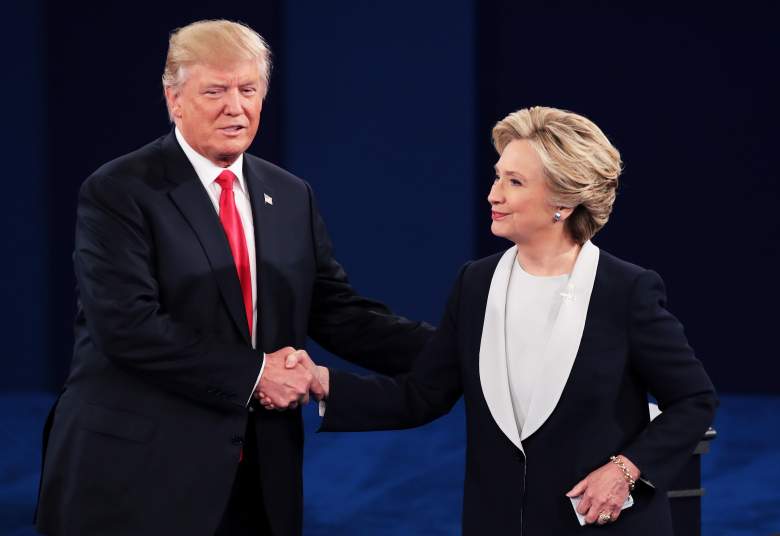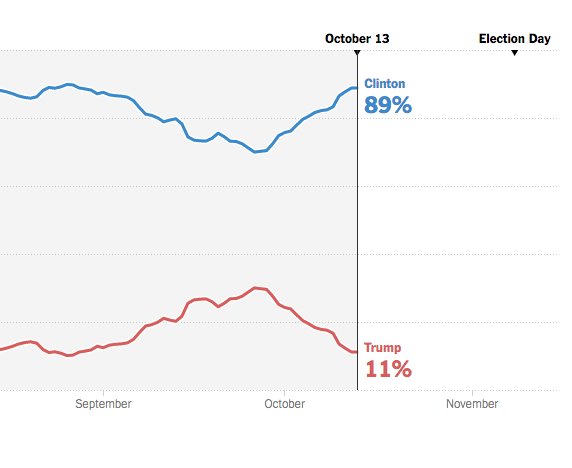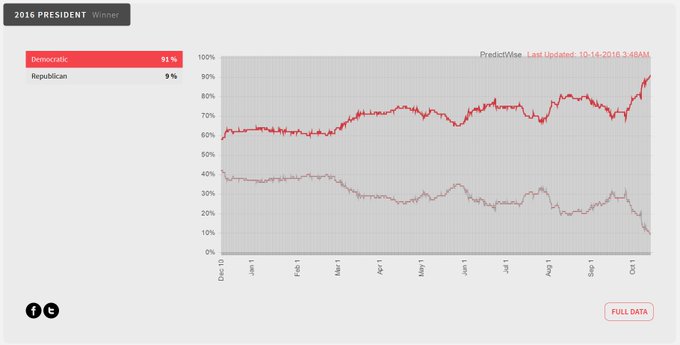
(Getty)
As the presidential election draws near, Hillary Clinton’s lead over Republican rival Donald Trump has widened into the middle of October.
Over the past three weeks, Clinton’s chances to win the presidency have increased across all election forecasts. Her lead over Trump has grown between five and nine percentage points nationwide, depending on which polls you count, and which candidates are included. According to the RealClearPolitics average of recent polls, Clinton leads Trump by 6.7 percentage points.
With just 26 days before the election, there isn’t a precedent for a candidate coming back to win this late in the cycle after being behind by as much as the polls indicate Trump is currently.
While it is possible the polls will tighten before Nov. 8, a Trump win is now extremely unlikely, as measured by every forecast.
Before the first presidential debate, there was a major deviation between some of the polls-based forecasts and market-based forecasts. However, the gap among the different election forecasts is steadily closing with Clinton near or even above 90 percent in most projections.
In this post, we revisit recent events that have influenced the race, as we compare various election forecasts. Each model takes a somewhat different view of how the race has evolved over the past six weeks, however each shows Clinton holding a prominent lead.
Here is a look at the latest forecast trends.
How Forecasts Compare
NYT Upshot: Clinton 89%, Trump 11%
The New York Times’ Upshot elections model suggests that Hillary Clinton is highly favored to win the presidency. Based on the latest state and national polls, Clinton has an 89 percent chance of winning the presidency compared to Trump’s 11 percent.
As the statistical Upshot model indicates, a victory by Trump is possible, but in sports terms, Clinton’s chance of losing is about the same as the probability that an NFL kicker misses a 34-yard field goal.
The Upshot model gave Clinton a 70 percent chance of winning to Trump’s 30 percent on September 27, however since then, Trump’s chances have plummeted while Clinton has experienced a steady climb.
FiveThirtyEight: Clinton 85%, Trump 15% (Polls-Only)
Trump’s path to the presidency is narrowing according to other forecasts as well. Nate Silver’s FiveThirtyEight polls plus forecast gives Trump an 19 percent chance compared to Clinton’s 81 percent. The polls plus forecast takes into account the polls, economy and historical data to make a prediction. Clinton has an 85 percent chance of winning in their polls-only forecast.
FiveThirtyEight’s Nowcast, which incorporates new polls very quickly, shows the Democratic nominee having an 87.5 percent chance of winning if the election were to be held today. According to the website, early-October polls, in most years, are close to predicting the winner– with a correlation of +0.96 between the polls and the final result.
PredictWise: Clinton 91%, Trump 9%
In addition to polling-based models from FiveThirtyEight, there is the PredictWise model, which uses information from betting markets to make a prediction.
As of Friday morning, PredictWise shows Clinton has a 91 percent probability of winning the election.
The PredictWise numbers tend to be more bullish about outcomes. For example, PredictWise gives Clinton has zero chance of winning over a conventionally red state like Arkansas, Alabama or Oklahoma, and shows Trump with zero chance of picking up blue states including California, Rhode Island and Maine.
Daily Kos: Clinton 96%, Trump 4%
Daily Kos shows Clinton currently has a 96 percent chance of winning the presidency.
On September 24, the Daily Kos Elections model showed Clinton hit her lowest mark with a 62 percent chance of winning in November. Ever since, she has been on an incline, with a steep rise on Oct. 4.
In a simulated electoral votes projection, Clinton has 328 compared to Trump’s 210.
Their projections take into account current polling data.
How States Have Shifted
As all of these models suggest, the likelihood of Trump getting to the White House is increasingly slimming.
To understand what is impacting the national trend, it is worth looking at the states where the winning probabilities have experienced the most change.
25 days before the election, Trump seeks 270 electoral votes needed to capture the presidency. Crucial swing states such as Pennsylvania, Michigan and Wisconsin are slipping out of his reach.
Additionally, some historically red states are now threatening to turn purple.
In one of the more surprising turns in the election, Trump and Clinton are tied at 26% in the very conservative state of Utah, according to a poll released on Wednesday by a Utah-based company called Y2 Analytics.
A NBC/WSJ/Marist poll out Thursday shows Trump is leading Clinton by one point in the battleground state of Ohio.
Based on the recent state predictions of UpShot, FiveThirtyEight and PredictWise, Trump is running out of ways to win. The GOP nominee needs to make up ground– especially in Pennsylvania, Michigan or Wisconsin.
According to CNN’s latest battleground map, Trump needs to capture one of those states to get more than the 270 electoral votes needed for victory, even if he won Ohio, Florida, North Carolina, Iowa, and Nevada.
What Has Recently Impacted the Predictions?
The Trump campaign has been reeling from a string of missteps, and damaging reports, including a 2005 recording of Trump which revealed demeaning comments about women. The tape showed him bragging about his ability to kiss and grope women based on his celebrity status.
The story dominated the news cycle heading into Sunday’s debate. Fallout from the tape caused major Republicans to pull their support of Trump. Since the leak of Trump’s vulgar comments about women on tape, nearly 20 percent of the 331 current Republican governors, Senators and House members have renounced their party’s nominee, according to Time.
The second presidential debate on Sunday gave Trump the chance to address the comments from 11 years ago. Trump said he was embarrassed by the tape, but repeatedly called the comments “just locker room talk.”
While more voters thought Trump did better this time around than in the first debate, scientific polls of registered voters showed Clinton winning the second debate.
Trump’s poll numbers rose briefly in September and then started to decline in early October. From a high of 45 points on October 2, he had lost 2.1 points going into the weekend of the second debate.
As Trump’s campaign tried to recover, more damaging headlines arose on Wednesday when the New York Times published a report of two women who alleged Trump had sexually assaulted them. Trump threatened to sue The New York Times for libel on Wednesday night in response to the article.
In addition to the New York Times article, other women have come forward with similar accounts. Mindy McGillivray alleged Trump made unwanted sexual advances in the Palm Beach Post and Cassandra Searles opened up about her experience on Facebook. Natasha Stoynoff, who is a journalist, claimed she was “physically attacked” by Trump in People.


